Advertisements
Advertisements
प्रश्न
A bank gives 10% Simple Interest (S.I.) on deposits by senior citizens. Draw a graph to illustrate the relation between the sum deposited and the simple interest earned. Find from your graph
(a) the annual interest obtainable for an investment of ₹ 250.
(b) the investment one has to make to get an annual simple interest of ₹ 70.
बेरीज
उत्तर
| Sum deposited | Simple interest for a year |
| ₹ 100 | ₹ `(100 xx 1 xx 10)/100` = ₹ 10 |
| ₹ 200 | ₹ `(200 xx 1 xx 10)/100` = ₹ 20 |
| ₹ 300 | ₹ `(300 xx 1 xx 10)/100` = ₹ 30 |
| ₹ 500 | ₹ `(500 xx 1 xx 10)/100` = ₹ 50 |
| ₹ 1000 | ₹ 100 |
We get a table of values.
| Deposit (in ₹) | 100 | 200 | 300 | 500 | 1000 |
| Annual S.I. (in ₹) | 10 | 20 | 30 | 50 | 100 |
(i) Scale : 1 unit = ₹ 100 on horizontal axis; 1 unit = ₹ 10 on vertical axis.
(ii) Mark Deposits along the horizontal axis.
(iii) Mark Simple Interest along the vertical axis.
(iv) Plot the points : (100,10), (200, 20), (300, 30), (500,50) etc.
(v) Join the points. We get a graph that is a line.
- Corresponding to ₹ 250 on the horizontal axis, we get the interest to be ₹ 25 on the vertical axis.
- Corresponding to ₹ 70 on the vertical axis, we get the sum to be ₹ 700 on the horizontal axis.

shaalaa.com
या प्रश्नात किंवा उत्तरात काही त्रुटी आहे का?
